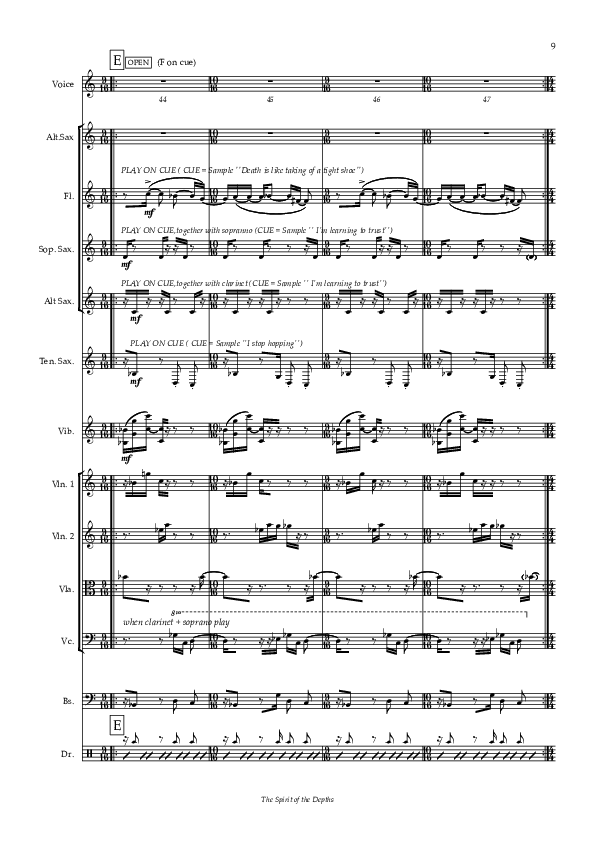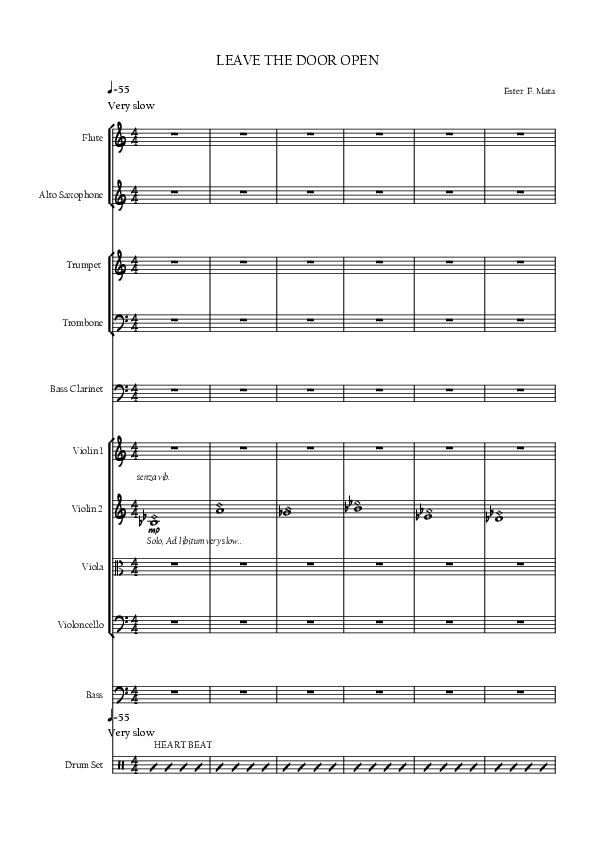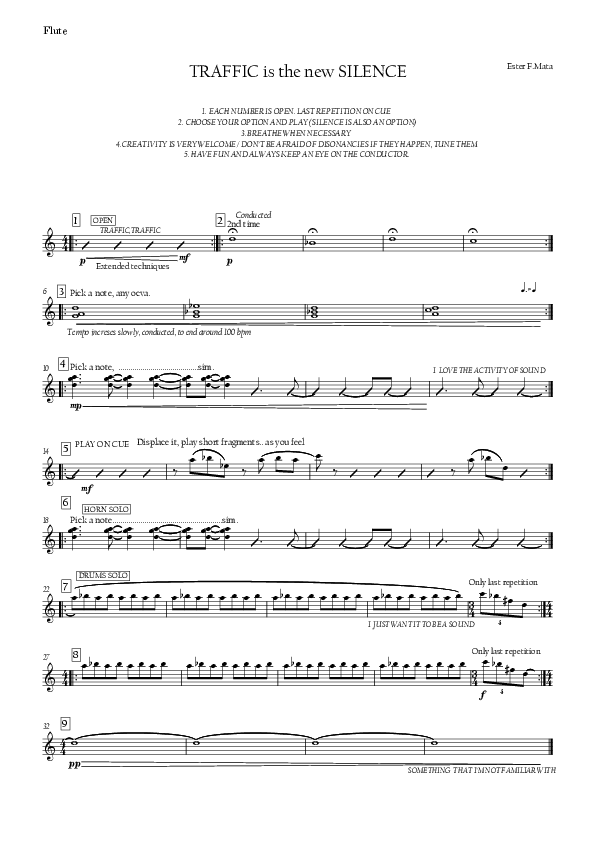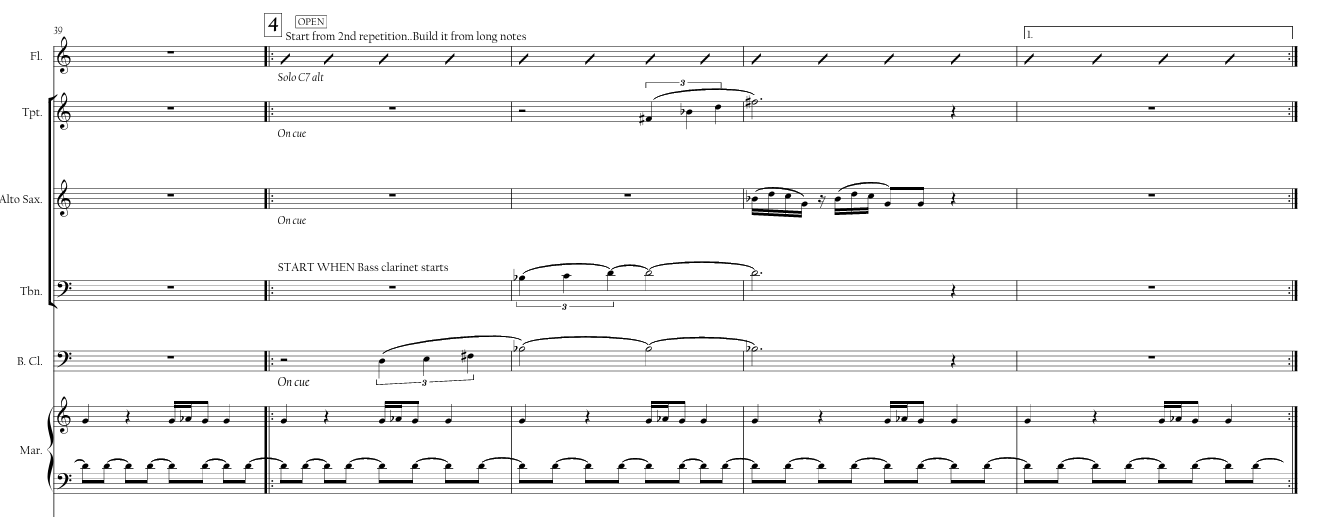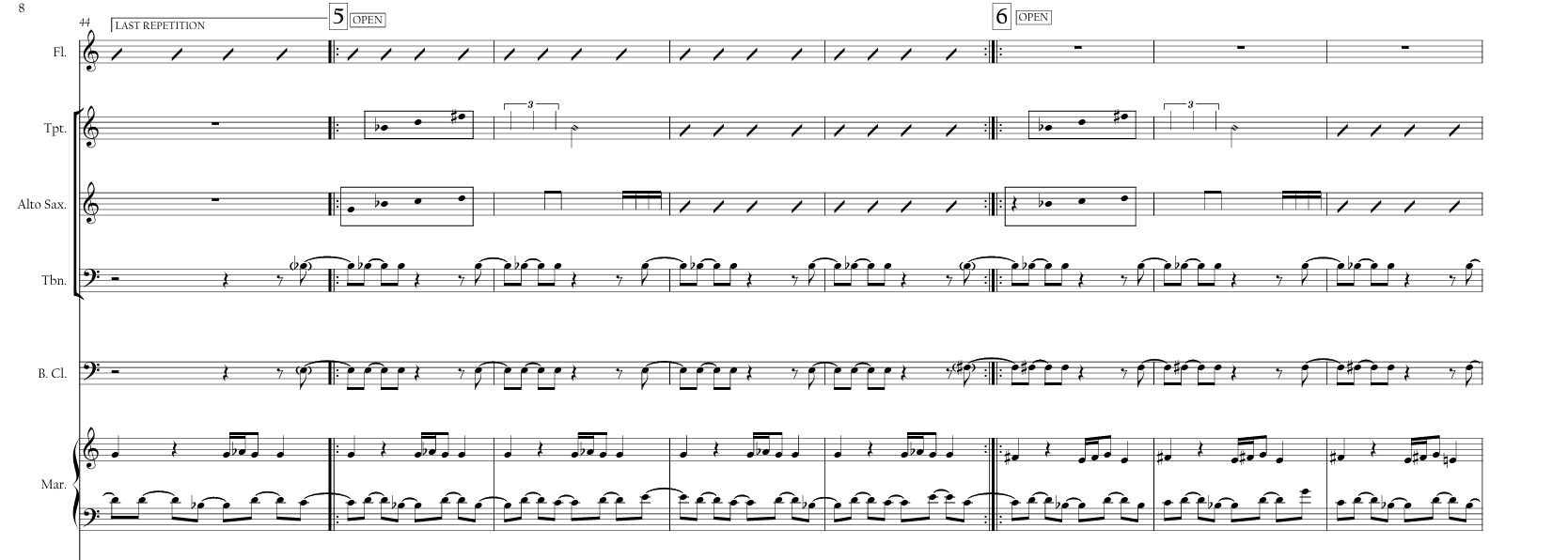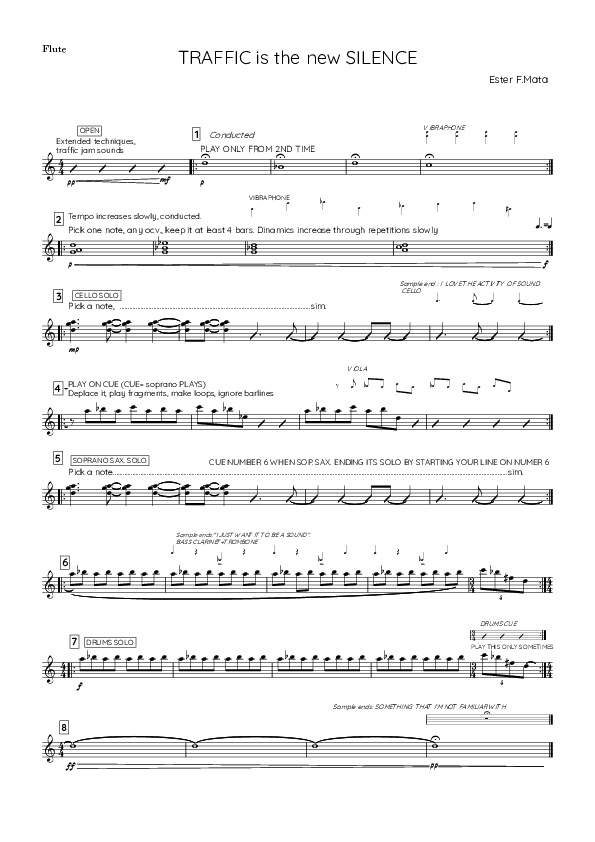Alongside the cues and who was giving them, what I found even more important was the ability to anticipate them clearly, allowing enough time for the rest of the ensemble to react. Additionally, incorporating body language alongside the specific cue made a significant difference. As we see in the first part of the video, I cue the rhythm section at the edge of the loop. While the vibraphone and bass players pick it up, the drummer does not. Later, my cues to the horns and strings are more clearly anticipated, with additional body language, which immediately makes the music sound more fluid and cohesive.
The first three to four rehearsals were crucial in revealing both the significant role that sign language would play in the project and the challenges it would introduce. While it offered greater variability and the ability to compose in real-time, it also posed difficulties in execution. I soon realized that conducting was consuming much of my attention, making it harder to focus on other musical elements. Additionally, when reviewing rehearsal recordings, I noticed that musicians were overly fixated on my cues rather than actively listening to the music and engaging with the ensemble.
To address this, among other things -like using electronic samples as cues (see below)-, I introduced a linked cue system, where musicians would signal each other through their playing instead of relying solely on me. This small change brought immediate improvements: it reduced my burden as a conductor and encouraged more organic interaction among the musicians. A prime example of this approach can be seen in Traffic is the New Silence. We compare two versions of the flute part:
Sign Language:
As mentioned in previous chapters, I have been influenced by Soundpainting (having performed in groups that used this sign language) and the Butch Morris 'Conduction' Method. However, since the primary goal was clarity for the musicians, we relied on a trial-and-error approach, testing different cues until we found gestures that felt both natural and easily understandable in the given context. A key example of this process can be seen in this excerpt from one of our first rehearsals (Oct 2023), where we refined the cues for "to play" and "beginning of a section" through discussion and experimentation.
Another notable example of how we developed notation is seen in Traffic is the New Silence and the 'extra' staves I created to facilitate the linked cue system I mentioned earlier. This approach was inspired by elements of aleatoric music as well as existing comprovisational scores (see Vistar 5 by Bhagwati). The additional staff above each section serves two purposes: indicating who will cue the transition to the next section -similar to its use in The Spirit of the Depths, where samples cue musicians to play (see below)- and defining the shape of the melodic cue. When it’s your turn to cue—in the flute example in section 5—there is no extra staff. Instead, a written explanation guides how to do it.
Electronic samples have also played a significant role in this comprovisational journey. Though not my initial focus, they became essential to most compositions and often served as their foundation. Within this redistribution of roles, electronics, performed by me, take on an interactive function too, acting as both an additional musician and, at times, a conductor. Samples can cue entire sections, as in Traffic, or specific musicians, as in The Spirit of the Depth. In 1,2,1, a solo section for violin, vibraphone, and electronics is intended to create a musical ‘conversation’ between them.
Notational development:
Finding our way to put in notation this comprovisational method we were exploring was also challenging. Charts were clearly changing in the first months, after every rehearsal. My first idea was, as often the music was loops that were evolving, to write them as simplified as I could (so over the original loop written I was adding more lines or options). But soon I realized that what was supposed to streamline the approach was making it more complex.
Ensemble roles:
If cues and notation presented challenges, adapting to new roles was essential for everyone. This included myself—I wanted to share decision-making with the musicians, but I had to adjust when their choices didn’t always align with my vision. This learning process took time and is still something we continue to develop. (Listen to this excerpt from a December 2024' rehearsal, more than a year into the ensemble project, where a musician still requests that ‘only one person’ make certain decisions in Traffic is the new silence)
Coming from classical and jazz backgrounds, we are all accustomed to a traditional ensemble structure: reading our parts, improvising when indicated—usually over a chord progression in jazz—and following the conductor for guidance. Stepping away from this conventional approach can be intimidating, and adjusting to a more collaborative setting, where musicians need to make creative decisions, varies in difficulty from person to person.
To facilitate this adjustment, I designed an exercise in which I reduced my leading and suggested material to the bare minimum, pushing the ensemble to rely solely on listening and generating ideas together. To do this, I transformed Leave the Door Open, originally a regularly notated piece, into a two-line score that leaned towards open improvisation. While the musical results aren't yet entirely satisfying, the process has encouraged deeper listening, greater self-awareness in relation to others, and a stronger sense of interaction and complementarity within the ensemble.
Leading a large ensemble is inherently challenging, but incorporating additional elements -such as conducting, electronic samples, and experimenting with new metrics to mention a few- adds layers of complexity. While I have experience leading smaller groups like jazz quintets, and even some Big Band projects, this opportunity has significantly contributed to my growth as a musician and composer.The project began in October 2023 with the formation of a jazz octet—consisting of five horns (flute, trumpet, alto saxophone, trombone, and bass clarinet) and a rhythm section (drums, double bass, and vibraphone)—combined with a string quartet. This ensemble was created as a platform to explore the intersection of composition and improvisation, aiming to seamlessly blend both elements. My goal has been to provide musicians with the freedom to express themselves while maintaining a sense of cohesion within the musical world envisioned for each piece. Over two years of research, we have developed six compositions with varying degrees of comprovisation. Throughout this process, some band members have changed due to personal reasons, instrumental considerations (with trumpet and trombone being replaced by soprano and tenor saxophones, respectively), or the need to find musicians best suited to the evolving music.
In this discussion, I will focus on three key pieces—Leave the Door Open, Music for 13 Musicians, and Traffic is the New Silence—as they have been particularly instrumental in shaping the project’s three core elements: Sign language, Notational development, and Ensemble roles. Additionally, I will reference other compositions to illustrate specific examples.
Excerpt of the piece Music for 13 Musicians. Number 4 in the first version (October 2023), Slide 1, transformed into Number 4,5 and 6 (Last version, January 2024), Slides 2-3.
This piece consists of various numbered open sections, allowing flexibility in the number of repetitions. In the first version, transitions between sections depended entirely on my cues. However, after several rehearsals, I realized that if musicians initiated the cues themselves, the piece would feel more cohesive, and decision-making would become more collaborative and creative—essentially composing the music in real-time. When implementing the second version, I noticed an even greater benefit: the flow between sections improved as musicians used material from the next section as a cue, making the cells more interconnected.
